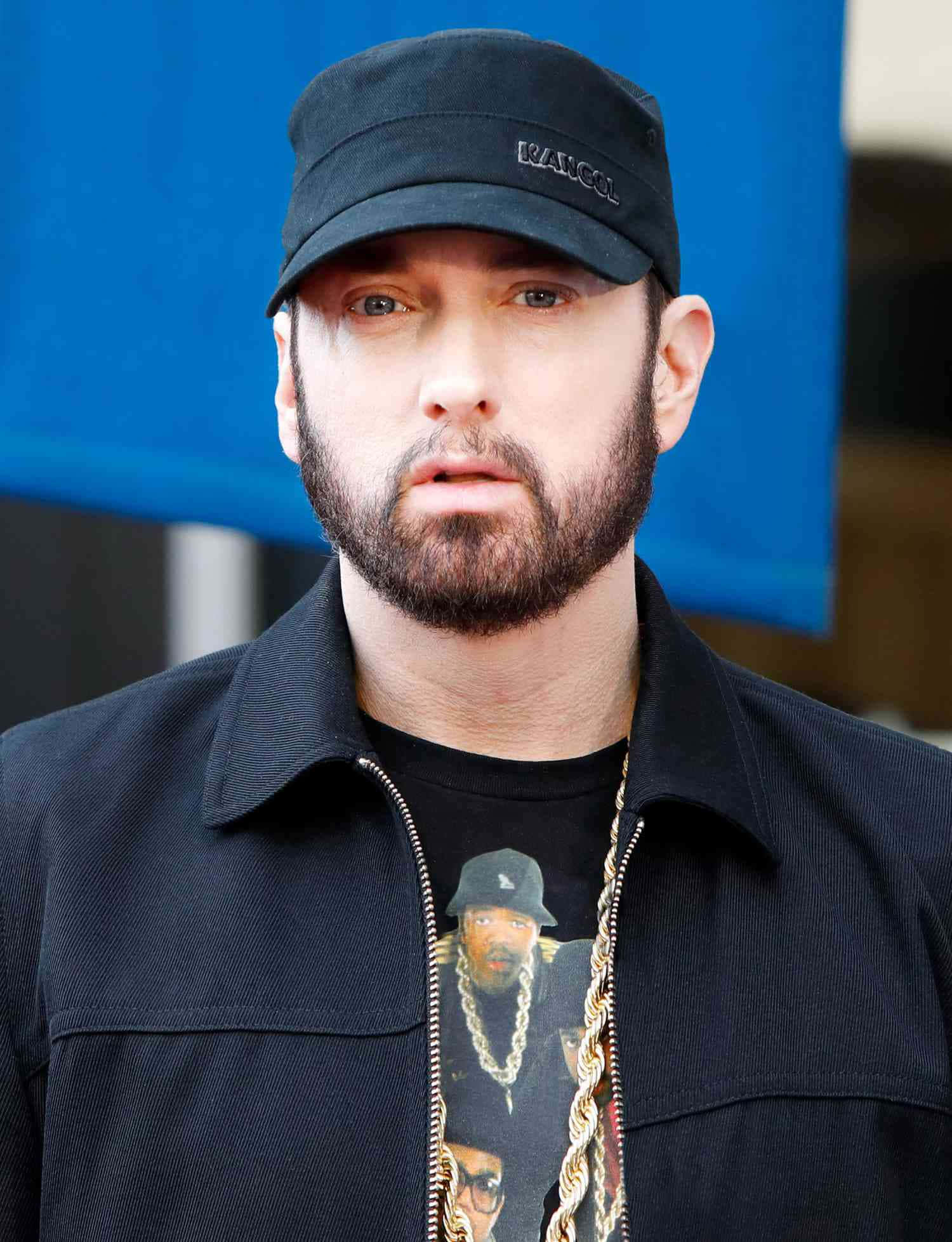The Eminem Clone Theory: Unmasking The Bizarre Conspiracy
In the vast and often perplexing world of celebrity conspiracy theories, few claims are as outlandish and persistent as the notion that Marshall Mathers III, famously known as Eminem, died in 2006 and was subsequently replaced by a clone or even an android. This bizarre theory, which has captivated and bewildered fans for years, suggests that the music industry orchestrated this switch to maintain control over the iconic rapper's career and continue generating revenue.
Despite overwhelming evidence to the contrary, and the sheer absurdity of the claim, the "Eminem clone" conspiracy continues to circulate online, fueled by resurfaced clips, speculative comparisons of his appearance, and the ever-present allure of a hidden truth. This article delves deep into the origins, alleged "proof," and logical debunking of this peculiar internet phenomenon, exploring why such a wild idea could gain traction among a segment of the public.
Table of Contents
- Eminem: A Brief Biography
- The Roots of the Eminem Clone Theory
- The So-Called "Evidence": A Closer Look
- Debunking the Eminem Clone Myth
- The Psychology Behind Conspiracy Theories
- Impact on Eminem's Legacy and Public Perception
- Conclusion: The Real Slim Shady Endures
Eminem: A Brief Biography
Before diving into the fantastical claims of the "Eminem clone" conspiracy, it's essential to ground ourselves in the reality of Marshall Mathers III's life and career. Born Marshall Bruce Mathers III on October 17, 1972, in St. Joseph, Missouri, Eminem rose from humble and often turbulent beginnings in Detroit to become one of the most influential and best-selling music artists of all time. His raw, confessional lyrics, intricate rhyme schemes, and controversial persona as "Slim Shady" redefined the landscape of hip-hop in the late 1990s and early 2000s.
- Iran National Volleyball Team Next Match Date
- Kaitlyn Frohnapfel Net Worth
- Mitchell Ryan
- Erin Napier Relationship Status
- Jennifer Harrison
Eminem's discography includes groundbreaking albums like "The Slim Shady LP," "The Marshall Mathers LP," and "The Eminem Show," all of which achieved massive commercial success and critical acclaim. He has won numerous awards, including 15 Grammy Awards, an Academy Award for Best Original Song for "Lose Yourself" from the film "8 Mile," in which he also starred. His career has been marked by periods of intense personal struggle, including battles with addiction, which he has openly addressed in his music. His resilience and ability to translate personal pain into universal anthems have cemented his status as a cultural icon, making him a prime target for the kind of bizarre speculation that gives rise to theories like the "Eminem clone."
Personal Data and Biodata: Marshall Bruce Mathers III (Eminem)
| Full Name: | Marshall Bruce Mathers III |
| Stage Name: | Eminem, Slim Shady, B-Rabbit |
| Date of Birth: | October 17, 1972 |
| Age: | 51 years old (as of late 2023 / early 2024) |
| Place of Birth: | St. Joseph, Missouri, U.S. |
| Occupation: | Rapper, Songwriter, Record Producer, Actor |
| Genre: | Hip hop |
| Years Active: | 1988–present |
| Labels: | Shady, Aftermath, Interscope |
| Children: | Hailie Jade Mathers, Alaina Marie Mathers, Stevie Laine Mathers |
| Notable Albums: | The Slim Shady LP, The Marshall Mathers LP, The Eminem Show, Encore, Relapse, Recovery, The Marshall Mathers LP 2 |
The Roots of the Eminem Clone Theory
The "Eminem clone" conspiracy theory didn't just appear out of thin air. According to various online sources like Ladbible, the Daily Star, and numerous YouTube videos, the theory gained traction sometime after 2006. This period is crucial because it aligns with a significant break in Eminem's recording career, specifically the five-year hiatus between his 2004 album "Encore" and his highly anticipated 2009 comeback album "Relapse." This extended period away from the public eye provided fertile ground for speculation and the seeding of the bizarre "Eminem clone" narrative.
The Alleged Death in 2006
At the very core of the conspiracy is the assertion that Eminem died in 2006. Different versions of the theory offer various, unsubstantiated causes of death: some claim it was a fatal car accident, while others point to a lethal overdose. One particularly notable theory, originating from a Spanish website, advances the idea that Eminem passed away in 2006, right in the middle of his five-year album break. This alleged death is the foundational event that, in the minds of theorists, necessitates the existence of an "Eminem clone." The complete absence of official reports, credible news sources, or any form of verifiable evidence confirming such a monumental event is, of course, conveniently overlooked or dismissed as part of the cover-up by proponents of the theory. It's a classic example of a conspiracy theory building its entire premise on an unproven, extraordinary claim.
- %C3%B8%C3%B9%CB%86%C3%B9%C6%92%C3%B9%C5%A1%C3%B8%C2%AA %C3%B8%C3%B9%C5%A1%C3%B8 %C3%B9%CB%86%C3%B9%C5%A1%C3%B9%C3%B9%C5%A1%C3%B8%C3%B9%C3%B8
- John Browning
- King Von Autopsy
- Debra Capriolgio
- Philippians 47
The Industry Control Narrative
Why would anyone go to such extreme lengths to replace a globally successful artist with a clone? The "Eminem clone" conspiracy theory posits that the music industry, often vaguely referred to as shadowy figures like the Illuminati or other powerful entities, wanted to maintain tighter, more absolute control over Eminem. By replacing the "real" Eminem with a clone, they could allegedly manipulate his output, image, and public persona to ensure continued profitability and adherence to their agenda. This narrative is a common thread in many celebrity conspiracy theories, where powerful, unseen forces are believed to pull the strings behind the scenes, sacrificing authenticity for control and profit. The idea is that the original, perhaps unruly or unpredictable, artist was replaced by a more compliant, controllable version. Some theories even delve into the specifics, mentioning "bone samples to clone rappers," as alluded to in a song by artist Tom MacDonald, further fueling the outlandish claims and giving them a pseudo-scientific veneer. The very notion of replacing a human with an "android" in 2006, as some versions suggest, highlights the disconnect between the theory and technological reality.
The So-Called "Evidence": A Closer Look
Proponents of the "Eminem clone" theory often point to several key pieces of "evidence" to support their claims. These usually revolve around perceived changes in Eminem's appearance, his lyrical content, and specific interview moments. However, upon closer inspection, this "evidence" quickly crumbles under scrutiny, revealing itself to be based on misinterpretations, selective observation, and a fundamental misunderstanding of human biology and behavior.
Appearance Changes Over Time
One of the most frequently cited pieces of "proof" for the "Eminem clone" theory is the noticeable change in Eminem's appearance over the years. Conspiracy theorists meticulously compare photos and videos from different eras of his career, particularly contrasting his look from the early 2000s (e.g., "The Marshall Mathers LP" era) with later periods (e.g., "The Marshall Mathers LP 2" era, 2013, 2017). They argue that his face and body have changed so dramatically that it must be a different person – a clone. As the provided data states, "I don't believe in the clone crap but i would say his appearance has changed more than literally any artist i can think of over the years." It also notes, "The changes on eminem's face and body is biological if you compare 2000s em to 2004 em you will see chnages same goes for 2004 eminem to 2009 eminem and again for 2013 eminem to 2017 eminem."
However, what these theories consistently fail to account for are the natural and entirely normal processes of aging, significant lifestyle changes, and the profound impact of addiction and subsequent recovery. Eminem has openly discussed his struggles with substance abuse, which can dramatically alter a person's physical appearance, leading to weight fluctuations, skin changes, and a generally worn look. As he got clean and aged, his body and face would naturally change. Furthermore, factors like celebrity grooming, evolving fashion choices, dental work, and even subtle cosmetic procedures (though unconfirmed for Eminem) can contribute to shifts in appearance. To attribute these perfectly normal biological and lifestyle-induced transformations to a clandestine cloning operation is not just a monumental leap in logic; it's a rejection of basic biological reality. His biggest change, as noted in the data, was "between MMLP to The Eminem Show," a period long before the alleged 2006 death, further undermining the core premise.
Lyrical Clues and Interview "Glitches"
Beyond physical appearance, some theorists meticulously scour Eminem's lyrics for hidden messages or "clues" about his alleged replacement. They might interpret certain lines as subtle acknowledgments of his death or the presence of a clone. Similarly, specific interviews are scrutinized for what are perceived as "glitches" in the clone's behavior – moments where the "clone" supposedly struggles to recall details, exhibits unusual mannerisms, or displays a momentary "freeze," suggesting a malfunction or artificiality. A particularly popular resurfaced clip, for instance, has been circulated online with conspiracy theorists believing it shows the moment the rapper's 'clone glitched'.
Yet, these interpretations are highly subjective and almost always involve confirmation bias. A true artist often incorporates elements of their past, their struggles, their triumphs, and even self-awareness into their work. The fact that the "clone rapper" supposedly remembers intricate details like dissing Ja Rule, having a beef with ICP, and recalling the "dark days of his rehab" (as noted in the data) actually serves as strong counter-evidence against the "Eminem clone" theory. If he were a clone, perfectly replicating a lifetime of complex



Detail Author:
- Name : Kavon Abernathy
- Username : cormier.keith
- Email : wbotsford@gmail.com
- Birthdate : 1998-04-20
- Address : 68208 Leola Loop Apt. 769 New Alessandro, LA 38895-7551
- Phone : +1-208-259-3862
- Company : Mitchell, Runolfsdottir and Turner
- Job : Structural Metal Fabricator
- Bio : Qui tempore pariatur tempore aperiam ipsum rerum a eum. Consequatur pariatur modi eum laboriosam modi. Dicta ratione sint earum ut enim. Sit ipsa aliquam vero ipsam qui et.
Socials
facebook:
- url : https://facebook.com/mafalda.wolf
- username : mafalda.wolf
- bio : Laboriosam autem autem dolores rem. Perferendis ullam rerum nostrum architecto.
- followers : 2674
- following : 2081
twitter:
- url : https://twitter.com/mwolf
- username : mwolf
- bio : Optio repellat ut voluptatem alias earum. Voluptatibus delectus voluptas ut architecto. Veritatis repellendus dignissimos sint.
- followers : 4719
- following : 2976
linkedin:
- url : https://linkedin.com/in/mafalda.wolf
- username : mafalda.wolf
- bio : Quod est ut nihil harum et.
- followers : 591
- following : 104
instagram:
- url : https://instagram.com/wolf2004
- username : wolf2004
- bio : Ullam rerum quo velit suscipit ea quidem. Voluptates animi nihil et neque. Natus fuga sint velit.
- followers : 6493
- following : 1450